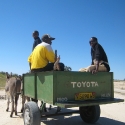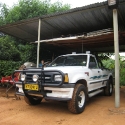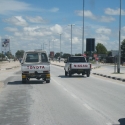 To put it straight at the beginning: I am not car freak. In Europe and abroad during holidays I used to be a fanatic public transport supporter. But it was obvious that a car in Namibia would become something essential due to huge distances, lack of (formal) public transport and the high risk of ending up in a car accident. Cars whether new or used are expensive here, even more expensive than in Switzerland. Due to that and the fact that new cars, stuffed with fancy electronic, are better only maintained in Windhoek a used car was the only choice.
To put it straight at the beginning: I am not car freak. In Europe and abroad during holidays I used to be a fanatic public transport supporter. But it was obvious that a car in Namibia would become something essential due to huge distances, lack of (formal) public transport and the high risk of ending up in a car accident. Cars whether new or used are expensive here, even more expensive than in Switzerland. Due to that and the fact that new cars, stuffed with fancy electronic, are better only maintained in Windhoek a used car was the only choice.
Does it has to be a 4×4?
That is up to you. Con: much higher investment, maintenance and fuel costs compared with a passenger car. Pro: cross-country mobility and safety. I bought a SUV for the mobility reason at first. After four months in the North I would do the same again, but primarily for the second, rather selfish reason. I am driving mostly on the tar road and the 4×4 mode was only needed in the garden during the rainy season so far. If you’re not regularly visiting the ‘Village’ of your neighbor (Alex:-) or remote schools it’s only the North-West where a 4×4 is needed. Safety in contrast matters.
Probably half of the cars here in the North are SUV’s with a net weight of ~1600Kg (a Toyota Land Cruiser S/C ‘workhorse’ has over 2000Kg). Most of them are equipped with a massive bullbar. A sedan, like the Toyota Corolla, has ~1100Kg – and you’re sitting one floor down. Good luck in there if you have a front crash with a fully packed Land Cruiser or just a suicidal donkey youngster.
Does it has to be a Toyota?
Unfortunately it does. Before coming to Namibia I had this topic ‘googled’ and discussed with people who had been in southern Africa before. The ‘desk research’ showed that it would had been wise to go for the Toyota brand – and not just because virtually every local is doing it. Despite this I let myself get talked into buying an overpriced, crappy, 96′ Mazda Drifter 4×4 (aka Ford Ranger) as a temporary solution because there was no suitable Toyota on the market the time I came to Windhoek.
Bad decision: as I am writing this text my Mazda has been grounded at the garage in Ongwediva since Monday and is waiting for spare parts from Windhoek. Not for the first time. During the last two months I’ve been almost every week at the garage. Used cars are prone to problems, even a Toyota Hilux (called the ‘indestructible’ car, and most seen 4×4 in Africa) won’t save you those troubles. The points are:

skills: there are just a few skilled and reliable mechanics in Ongwediva, Oshakati or Ondangwa. Even with them it is likely that you bring the car with one problem and collect it with another the next day – with a popular Toyota Corolla or Hilux chances are that they know what they’re doing. A garage in Outapi is a place with a bunch of guys who claim to be car mechanics, if you’re lucky they also have a few tools. If they can fix anything at all it is a Toyota without electronic components.
spare parts: for popular Toyota models dealers (e.g CYMOT) in the North have them in stock and the scrapyards are full of ‘second hand’ parts. For Nissan, Mazda, Isuzu & Co. they often have to be ordered from Windhoek or South Africa first and are more expensive.
Still not convinced? Let the market forces play. A Toyota Hilux 4×4 (S/C, petrol, build ~2000, ~160’000Km) costs around US$16’500. Similar vehicles from Nissan & Co. are at the average to have for US$14’000. I don’t think the Namibian customer just pays the premium for the fancy Toyota sticker on the back of the car.
Okay, economists have been proofed wrong not so long ago. Let me quote the official NISSAN dealer in Windhoek: “In the North go for an old, diesel Toyota or Land Rover. Any guy with a screwdriver can fix those cars.”. Maybe they men was going for early retirement the next day, but I think he was just the only honest car dealer in the city I’ve met.